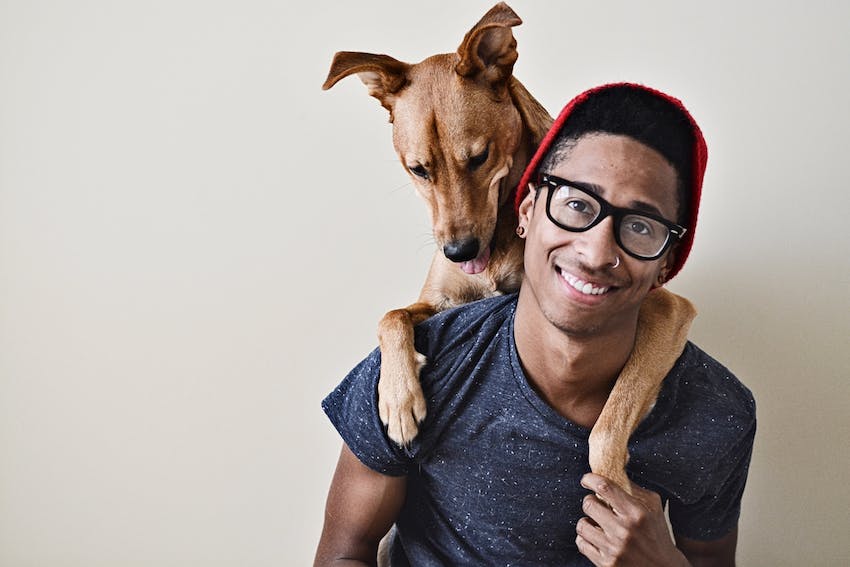Ready to help treat your pet to a healthy life?
How to Calm a Stressed Dog During the Holidays
By : Kelli Rascoe & Trupanion Staff | Published Nov 14, 2024

The holidays are fun-filled, joyous, times... for humans. For dogs, the winter holiday season can be an overwhelmingly stressful experience. As responsible pet owners, it is beneficial for your pets — as well as your family — to know how to ease canine stress. Not only will this help make the season a more joyous time for all, but it will also help prevent holiday accidents due to pet stress (at Trupanion, we tend to see a rise in accident-related claims during this time).
Whether you’re traveling with your pets for the holidays or hosting a house-hold full of guests, every experience can be new and challenging for your dog, resulting in unexpected behaviors. By learning how to recognize these behaviors and their triggers, you can become capable of calm your stressed-out dog during the holidays. Here's what you need to know.
How do I tell if my dog is stressed?
It can be tough to detect when your new puppy or adult dog is experiencing the stress of a new situation. If you are a new pet owner (and it's your dog's first holiday season), you might still be learning your pup’s behaviors and cues. Look out for these signs so that you know when you may have to calm a stressed dog:
- Excessive self-licking and cleaning
- Wide eyes
- Avoidance/looking away
- Ear pinned back
- Panting
- Stiffness
- Lip licking
- Shaking
- Paw lifting
- Pacing
How to calm a stressed dog
If you are introducing a new environment like a holiday party, or a new routine such as travel, consider making the experience as comfortable as possible for your dog. Distracting your pet with physical and mental stimulation can prevent stress overload and do wonders to help calm a stressed dog. Consider including interactive playtime with enrichment toys, like puzzle games. Take your time and remember that it will take time for your pup to become accustomed to new people, places, sounds and events.
Further, if you are concerned with your dog’s stress level or behavior, seek medical care with your veterinarian. Under your veterinarian’s expertise and guidance, a treatment plan and regime can be put in place to help your pup through the stress. Make note of the stressors and environments that your dog is reacting to so you can discuss their anxiety and behaviors with your veterinarian.
The holidays can be a hazardous time in general for pets, which also increases stress and anxiety for all. Learn common holidays hazards this season to protect humans and canines alike.

Preventing holiday stress in dogs
Each dog can react differently to new environments, situations, and meeting new pets and people. So when exposing your pet to a new environment or situation, take your time, and take into consideration that your pup might not respond as you initially expected. For example, it might take several trips to the airport for your dog to become acclimated to travel. Especially during the holidays, when more and more people are traveling, allow your dog some extra time to get acclimated.
Going to be around a lot of new people and possibly other pets? Whatever you do, don’t force socialization. All dogs should be given the chance to become properly socialized, of course, but busy holiday gatherings and airports are not the right environments for this. Instead, only bring your dog into these situations if they've already been properly trained and can handle them.
Tips for flying with a dog
If you're planning on flying with your dog this year, this will require extra precautions. Flying can be extremely stress-inducing for dogs, especially for those who travel in the cargo hold. And for those who do travel in the cabin, they must be on their best-behavior or risk getting kicked off or banned. In other words, it's in everyone's best interest for your dog to fly stress-free.
So, how do you do that? Every dog is different, but there are some things you can do to help prevent air travel stress and anxiety in pets:
- Read up on the rules for traveling with your dog with both the airport and airline beforehand. You don't want any unwelcome surprises!
- Practice bringing your dog in busy public spaces. While you can't go through airport security without a ticket, you might want to consider bringing them around the check-in area and baggage claim to help them get accustomed to the stimuli.
- Bring snacks for your pet, but ensure they eat and drink water beforehand.
- Bring your pet on a long walk before leaving for the airport — additional exercise can help make them more sleepy and calm.
- Talk with your veterinarian for additional tips. If you really need to travel with your dog and they are extra anxious, your vet may also be able to prescribe something to help.
At the end of the day, some dogs may be best left at home this season. Enlist the help of a dog sitter you trust, and arrange for both you and your pet to enjoy the holidays in peace.
Don't let holiday fun get in the way of your dog's well-being
As a new pet owner, there is no way to predict what your dog will respond to or have a stressful reaction to. “If you know that your dog is stressed or reactive in certain situations, try to avoid them,” states Halvorsen. Further, by checking in with your veterinarian and establishing a treatment plan, you can work as a team to help your dog’s stress preemptively. Certainly, seeing your dog stressed can be stressful for you and your family. Allow time and patience for everyone to adjust to new schedules and scenarios.
Take caution when approaching other people's dogs
Pets are family, and people are traveling more frequently with their pets as a result. From going through airports and train stations to bringing dogs to holiday parties, there's a good chance you'll encounter some new pups this season. Although this can be fun of course, not every dog is going to be receptive to new attention. Some dogs will already be stressed by being unsure of their surroundings — or even potentially off-leash.
If you see a dog who may be shy, stressed, or reactive, the best way to approach would be cautiously, and remember to communicate with the owner of the dog. Remember to read their body language — does the dog seem relaxed? Are the eyes open or mouth tensed? Are there hackles raised? Everything from loud noises to visual stimuli, such as children, boots, or people in hats, could be a potential trigger for a dog.
Consider sitting at their level so that you don’t appear to be a threat. Essentially, depending on the dog’s stress level, it may be best to not approach them at all. Use your judgment and if you have not met this pet before, consider taking a step back and letting them come to you.
Although your pup might be open to interaction and play with a new furry friend, it doesn’t mean that other dogs feel the same way. Always ask the owner before interacting with their dogs — or before introducing their pets to yours.

The bottom line
Every dog has a different response to a new experience, interaction, or environment. But by identifying your dog’s stressors and being able to spot those in others, you can help maintain a happy and safe holiday season for all. And while your pet's wellbeing is on your mind, be sure to explore your dog insurance options if they're not already protected.
